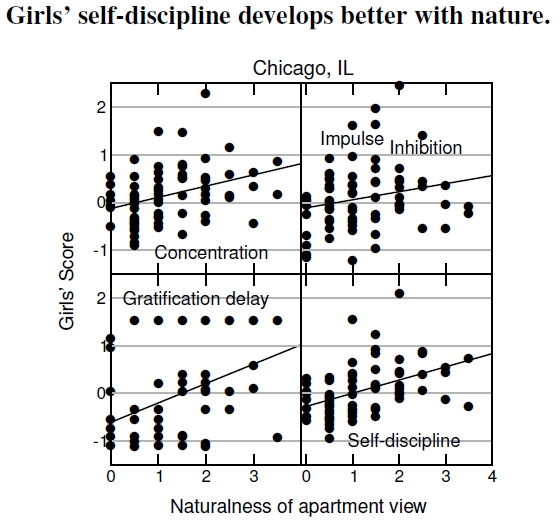5.10 Girls & Nature
 Figure 5.10: Girls experienced enhanced self-discipline development at the Robert Taylor Homes in Chicago, Illinois, with better views of vegetation from their apartment windows (after Taylor et al. 2002). Three separate measures—concentration, delay of gratification, and impulse inhibition—and their combined “self-discipline” measure, show statistically significant increasing trends with vegetation. Girls outperformed boys in concentration and impulse inhibition, whereas boys outperformed girls in delay of gratification. Boys’ overall development showed no statistically significant trends with vegetation.
Figure 5.10: Girls experienced enhanced self-discipline development at the Robert Taylor Homes in Chicago, Illinois, with better views of vegetation from their apartment windows (after Taylor et al. 2002). Three separate measures—concentration, delay of gratification, and impulse inhibition—and their combined “self-discipline” measure, show statistically significant increasing trends with vegetation. Girls outperformed boys in concentration and impulse inhibition, whereas boys outperformed girls in delay of gratification. Boys’ overall development showed no statistically significant trends with vegetation.
Does vegetation help children develop better? A study carried out at the Robert Taylor Homes (described on page 149) examined just that question.[43]
Researchers recruited four housing development residents, all of them African American women between the ages of 30 and 45, and trained them intensively to carry out one-on-one survey interviews with interviewees they had never previously met. Overall, the study included 169 interviews, with each interview involving both a mother (or primary caregiver) and a child. The children, all aged 7 to 12, included 91 boys and 78 girls. Furthermore, during the interviews, childcare providers entertained children who were not involved in the interview, removing this child-care distraction.
Interviewees rated nature, as viewed from their apartment, on a five-point scale.[44] Concentration involved four tasks—substitutions, sequences, reverse alphabet recitation, and image recognition—combined into a single score. Three tasks measured impulse inhibition: matching detailed and similar images, reciting color names printed in incongruent colors, and matching conceptually similar icons. Each task involved resisting an impulse to quickly provide answers that demand careful consideration. Finally, interviewers measured “delay of gratification” using small and large bags of a child’s preferred candy: The interviewer told the child that he or she could have the large bag if the child could wait long enough (up to a maximum waiting time of 15 minutes), then told the child to close his or her eyes and take the candy out of the room. The child’s delay of gratification score relates to how long he or she could wait for the large bag of candy.
In summary, “green views” from a girl’s window enhanced her development, at least as measured by the four scores studied here, but boys’ development did not. Overall, girls exceeded boys at concentrating and inhibiting their impulses (see Figure 5.10), although boys exceeded girls in the delay of gratification study, with girls waiting an average of 358 seconds versus 454 seconds for boys. Thus, boys could delay their gratification longer, but the delay did not depend on vegetation. There was one explanation for the difference between boys and girls: Some evidence shows that boys play further away from home than do girls, and are less affected by near-home nature.
The study points out one cautionary note, among several: Mothers with a positive outlook might rate their views greener (more positively), and because of their positive outlook, their children have a more positive development. Thus, the mother’s outlook correlates the rating of nature and the development of girls. However, boys should also be affected by this correlation.
—————————
[43]Taylor et al. (2002) studied childhood development in the Taylor Buildings in Chicago, Illinois, and provide a broad review of attention restoration theory. Children are not alone in their benefiting from nature: Benefits also extend to adults in that natural views at one’s residence have a restorative effect when one is suffering from fatigue.
[44]In contrast to the studies I described previously in Figure 5.9, this one determined the “greenness” of a view through the interviewees themselves. Two questions were used and combined: “How much of the view from your window is of nature (trees, plants, water)?”, and the reverse, “How much of your view from your window is man-made (buildings, street, pavement)?” Responses ranged from 0 = not at all to 4 = very much.
I found these quotes:
“From my favorite spot on the floor I look up at the blue sky and the bare chestnut tree, on whose branches little raindrops shine, appearing like silver, and at the seagulls and other birds as they glide on the wind … while this lasts I cannot be unhappy.”
Anne Frank, Feb. 23, 1944.
“How could I have suspected that it meant so much to Anne to see a patch of blue sky, to observe the gulls during their flight and how important the chestnut tree was to her, as I recall that she never took an interest in nature. But she longed for it during that time when she felt like a caged bird. She only found consolation in thinking about nature. But she had kept such feelings completely to herself.”
Otto Frank, 1968.